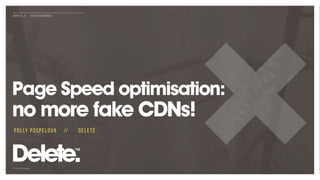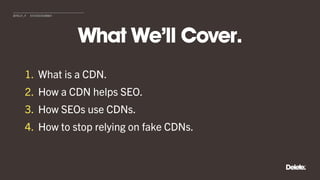Page speed optimisation: No more fake CDNs!
- 1. ? 2019 Delete @POLLY_P #TECHSEOSUMMAT Page Speed optimisation: no more fake CDNs! POLLY POSPELOVA // DELETE
- 2. @POLLY_P #TECHSEOSUMMAT 1. What is a CDN. 2. How a CDN helps SEO. 3. How SEOs use CDNs. 4. How to stop relying on fake CDNs. What WeˇŻll Cover.
- 3. @POLLY_P #TECHSEOSUMMAT As SEOs, we all want to achieve better ranking in the SERPs.
- 4. @POLLY_P #TECHSEOSUMMAT ? Relevant, useful and original content ? Trustworthiness ? Backlink factors ? Brand Signals ? Low page loading time ? Site speed
- 5. @POLLY_P #TECHSEOSUMMAT What is a CDN?
- 6. ? Copyright 2019 Delete @POLLY_P #TECHSEOSUMMAT
- 7. @POLLY_P #TECHSEOSUMMAT How does a CDN help SEO?
- 8. @POLLY_P #TECHSEOSUMMAT 1. Speed is a ranking factor.
- 9. @POLLY_P #TECHSEOSUMMAT 2. Speed effects bounce rate and conversions.
- 10. @POLLY_P #TECHSEOSUMMAT 3. Speed effects revenue.
- 11. @POLLY_P #TECHSEOSUMMAT How SEOs use CDNs.
- 13. ? Copyright 2019 Delete @POLLY_P #TECHSEOSUMMAT HTTP/1
- 14. ? Copyright 2019 Delete @POLLY_P #TECHSEOSUMMAT c
- 15. ? Copyright 2019 Delete @POLLY_P #TECHSEOSUMMAT 140 / 6 ˇÖ 23
- 16. ? Copyright 2019 Delete @POLLY_P #TECHSEOSUMMAT HTTP/1 Connections Limit Browser Version Connections Per Hostname Max Connections Chrome 34/32 6 10 IE9 6 35 IE10 8 17 IE11 13 17 Firefox 27/26 6 17 Safari 7.0.1 6 17 Chrome Mobile 6 16 IE Mobile 9 6 60 Source: http://www.browserscope.org/?category=network&v=top
- 17. @POLLY_P #TECHSEOSUMMAT Fake CDNs example: https://old.deleteagency.com
- 18. ? Copyright 2019 Delete @POLLY_P #TECHSEOSUMMAT
- 19. ? Copyright 2019 Delete @POLLY_P #TECHSEOSUMMAT
- 20. ? Copyright 2019 Delete @POLLY_P #TECHSEOSUMMAT
- 22. ? Copyright 2019 Delete @POLLY_P #TECHSEOSUMMAT CDN can drastically increase the speed of your website, but it doesnˇŻt solve render- blocking resources issues. If you have a lot of render-blocking resources, you might still experience delays.
- 23. ? Copyright 2019 Delete @POLLY_P #TECHSEOSUMMAT c
- 24. ? Copyright 2019 Delete @POLLY_P #TECHSEOSUMMAT Abrowser doesnˇŻtstart rendering apageuntilitloads andparsesallresources.
- 25. ? Copyright 2019 Delete @POLLY_P #TECHSEOSUMMAT We only take the necessary resources (JS, CSS) for a page and then inline them into HTML markup, in a <head> tag. c
- 26. ? Copyright 2019 Delete @POLLY_P #TECHSEOSUMMAT After theinlinemarkuploads, wethenload allthe necessaryresourcesin thebackgroundand cachethem.
- 27. ? Copyright 2019 Delete @POLLY_P #TECHSEOSUMMAT We check if the browser already has the resources cached and we skip inlining.
- 28. ? Copyright 2019 Delete @POLLY_P #TECHSEOSUMMAT The content loads instantly on the ?rst and all subsequent loads.
- 30. ? Copyright 2019 Delete @POLLY_P #TECHSEOSUMMAT HTTP/1 HTTP/2
- 31. ? Copyright 2019 Delete @POLLY_P #TECHSEOSUMMAT No more fake CDNs.
- 32. @POLLY_P #TECHSEOSUMMAT 1. Stream multiplexing. 2. Explicit stream dependencies. 3. Server Push. 4. HPACK (the silent killer feature).
- 33. ? Copyright 2019 Delete @POLLY_P #TECHSEOSUMMAT Multiplexing is a method by which multiple HTTP requests can be sent and responses can be received asynchronously via a single connection. Multiplexing is the heart of HTTP/2 protocol. Stream multiplexing.
- 34. ? Copyright 2019 Delete @POLLY_P #TECHSEOSUMMAT A browser can assign a priority for a new stream by including prioritisation information in the HEADERS. Explicit stream dependencies.
- 35. ? Copyright 2019 Delete @POLLY_P #TECHSEOSUMMAT Server Push enables websites speculatively deliver content to the web browser before the browser sends a request for it. Server Push.
- 36. ? Copyright 2019 Delete @POLLY_P #TECHSEOSUMMAT HTTP/2 supports a new dedicated header compression algorithm, called HPACK. HPACK.
- 37. @POLLY_P #TECHSEOSUMMAT No more fake CDNs example: https://www.deleteagency.com
- 38. ? Copyright 2019 Delete @POLLY_P #TECHSEOSUMMAT
- 39. ? Copyright 2019 Delete @POLLY_P #TECHSEOSUMMAT
- 40. ? Copyright 2019 Delete @POLLY_P #TECHSEOSUMMAT
- 41. @POLLY_P #TECHSEOSUMMAT You can't do it alone!
- 42. ? Copyright 2019 Delete @POLLY_P #TECHSEOSUMMAT Thank you.









































